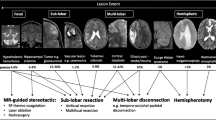Abstract
In pediatric patients, brain tumors have been estimated to be the cause for seizures in only 0.2–0.3 % of cases, whereas seizures occurred in about 13 % of pediatric brain tumor patients at presentation. This survey was conducted to analyze EEG findings in pediatric tumor patients over the past 14 years to evaluate the diagnostic value of preoperative EEG for diagnosis of brain tumors. Surface EEG was obtained in awake patients using the international 10- to 20-electrode placement in all pediatric patients with intracranial neoplasms between 2000 and 2013 at the University Hospital of Leipzig except for those who needed emergency operative treatment. One hundred forty-two pediatric patients with 80 infratentorial and 62 supratentorial tumors (WHO grades I–II: 91 patients; WHO grades III–IV: 46 patients). Symptomatic hydrocephalus was found in 37. Sensitivity and specificity of ophthalmologic examination for predicting hydrocephalus was 0.39 and 0.72. Preoperative EEG has been conducted in 116 patients, showing normal activity in 54 patients (47 %). Out of 62 pathologic EEGs, 40 indicated correctly to the site of the lesion, 15 were pathologic despite of infratentorial location of the tumor. Nineteen patients had a history of seizures of which six had normal EEGs. Sensitivity for and specificity of EEG examination for symptomatic epilepsy was 0.68 and 0.7.
Conclusion Preoperative routine EEG provides no additional value in the diagnostic algorithm of pediatric train tumors. The low specificity and sensitivity of EEG (even in patients with clinical seizures as primary symptom of a brain tumor) underline that EEG does not contribute to diagnosis and a normal EEG might even delay correct diagnosis.
Similar content being viewed by others
Abbreviations
- AT/T:
-
Atypical teratoid/rhabdoid tumor
- CSF:
-
Cerebral spinal fluid
- DNET:
-
Dysembryoplastic neuroepithelial tumor
- DOGLT:
-
Disseminated oligodendroglial-like leptomeningeal tumor
- EEG:
-
Electroencephalogram
- GBM:
-
Glioblastoma
- PA:
-
Pilocytic astrocytoma
- PNET:
-
Primitive neuroectodermal tumor
References
Cascino GD (1990) Epilepsy and brain tumours. Epilepsia 37:S37–S44
Duffner PK (2010) Risk factors for cognitive decline in children treated for brain tumors. Eur J Pediatr Neurol 14:106–115
Edgeworth J, Bullock P, Bailey A, Gallagher A, Crouchmann M (1996) Why are brain tumours still being missed? Arch Dis Child 74:148–151
Fattal-Valevski A, Nissan N, Kramer U, Constantini S (2012) Seizures as the clinical presenting symptom in children with brain tumours. J Child Neurol 28:292–296
Flores LE, Williams DL, Bell BA et al (1986) Delay in the diagnosis of pediatric brain tumors. Am J Dis Child 140:684–686
Gilles FH, Sobel E, Leviton A et al (1992) Epidemiology of seizures in children with brain tumors. The Childhood Brain Tumor Consortium. J Neurooncol 12:53–68
Hayashi N, Kidokoro H, Miyajima Y, Fukazawa T, Natsume J, Kubota T, Kojima K (2010) How do the clinical features of brain tumours in childhood progress before diagnosis? Brain Dev 32:636–641
Hirtz D, Ashwal S, Berg A, Bittis D, Camfield C, Camfield P, Crumrine P, Elterman R, Schneider S, Shinnar S (2000) Practice parameter: evaluating a first nonfebrile seizure in children. Report of the Quality Standards Subcommittee of the American Academy of Neurology, the Child Neurology Society, and the American Epilepsy Society. Neurology 55:616–623
Ibrahim K, Appleton R (2004) Seizures as the presenting symptom of brain tumours in children. Seizure 13:108–112
Klitbo DM, Nielsen R, Illum NO, Wehner PS, Carlsen N (2011) Symptoms and time to diagnosis in children with brain tumours. Dan Med Bul 58:A4285
Kukal K, Dobrovoljac M, Boltshauer E, Ammann RA, Grotzer MA (2009) Does diagnostic delay result in decreased survival in paediatric brain tumours? Eur J Pediatr 168:303–310
Martens D, Oster I, Gottschling S, Papanagiotou P, Ziegler K, Eymann R, Ong MF, Gortner L, Meyer S (2012) Cerebral MRI and EEG studies in the initial management of pediatric headaches. Swiss Med Wkly 142:w13625
Metha V, Chapman A, McNeely PD, Walling S, Hower WJ (2002) Latency between symptom onset and diagnosis of pediatric brain tumors: an Eastern Canadian geographic study. Neurosurgery 51(2):365–372, discussion 372–3
Patel H, Garg BP, Salanova V, Boaz JC, Luerson TG, Karlsbeck JE (2001) Tumor-related epilepsy in children. J Child Neurol 16(2):141–145
Pavone P, Conti I, Le Pira A, Pavone L, Verrotti A, Ruggieri M (2011) Primary headache: role of investigations in a cohort of young children and adolescents. Pediatr Int 53:964–967
Reulecke BC, Erker CG, Fiedler BJ, Niederstadt TU, Kurlemann G (2008) Brain tumors in children: initial symptoms and their influence on the time span between symptom onset and diagnosis. J Child Neurol 23:178–183
Sjors K, Blennow G, Lantz G (1993) Seizures as the presenting symptoms of brain tumors in children. Acta Paed 82:66–70
Williams BA, Abbott KJ, Manson JI (1992) Cerebral tumors in children with epilepsy. J Child Neurol 7:291–294
Wilne SH, Ferris RC, Nathwani A, Kennedy CR (2006) The presenting features of brain tumours: a review of 200 cases. Arch Dis Child 91:502–506
Wilne S, Collier J, Kennedy C, Koller K, Grundy R, Walker D (2007) Presentation of childhood CNS tumours: a systematic review and meta-analysis. Lancet Oncol 8:685–695
Wilne S, Koller K, Collier J, Kennedy C, Grundy R, Walker D (2010) The diagnosis of brain tumours in children: a guideline to assist healthcare professionals in the assessment of children who may have a brain tumour. Arch Dis Child 95:534–539
Wilne SH, Dineen RA, Dommett RM, Chu RPC, Walker DA (2013) Identifying brain tumours in children and young adults. BMJ 347:f5844
Ethical standard statement
A local ethics committee approval had been granted for retrospective analysis of the data (Ethikkommission Universität Leipzig, Az 134-13-03062013).
Author information
Authors and Affiliations
Corresponding author
Rights and permissions
About this article
Cite this article
Preuß, M., Preiss, S., Syrbe, S. et al. Signs and symptoms of pediatric brain tumors and diagnostic value of preoperative EEG. Childs Nerv Syst 31, 2051–2054 (2015). https://doi.org/10.1007/s00381-015-2842-z
Received:
Accepted:
Published:
Issue Date:
DOI: https://doi.org/10.1007/s00381-015-2842-z




